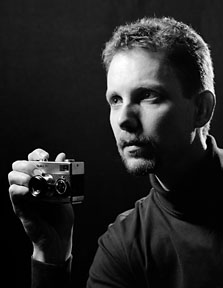Cameras: time to trade film for digital?
For those ending up here after finding my photography site, this post is for you. In the last year, I've been heavily involved with music and haven't done as much photography as I'd been doing previously. However, I have taken a few photos that have received fairly wide exposure, namely this one, this one and this one of violinist and conductor David Felberg; and this one of my string quartet; and then this one of a product, also found here.
And during the process of taking the above product photograph, I used a digital camera. This of course was not my first time with a digital camera... but during this session, I also shot with a film camera - my trusty Hasselblad 503cw. The main thing that I noticed was that halfway through the session, I stopped shooting on film and concentrated on getting the image with the digital camera. For one thing, I could run back to the computer, load up the image, and see exactly what it looked like. Not just a polaroid but the EXACT image.
Not only that, but once I was done with the digital image, I was DONE. No waiting for the lab, no scanning, no color correcting... you see the point. The other images (of David Felberg and the string quartet) were shot on film. And frankly, the quality is still superior. And I wasn't in as much of a hurry as with the product photo.
Here's the dilemma: to get into a digital system, such as Canon's EOS 20D, which I consider to be the bare minimum equipment to do pro work, particularly connected to studio lighting, I would need to sell almost all the equipment I have in order to get into the new system. Bodies (I would probably also get a film body, such as the EOS3, lenses, and a few accessories add up quickly.
It seems that now is the time to unload medium-format equipment because the price is falling and probably won't recover anytime soon. But to give up the medium format system, particularly my "dream camera", the Hasselblad seems a shame. It's a camera I'd like to pass down instead of just liquidating. And it seems that film in 120 format will probably be available for at least another decade. But after that - what happens? The rest of the cameras I'm not as attached to, such as the Olympus and the Contax despite the fact that they are excellent cameras.
Maybe there's another way... maybe I can sell off the 35mm stuff and keep the MF stuff, and put a little cash into this... Hmmm gotta find a way to generate some extra cash and make this happen while keeping the Hassy and the Zeiss German lenses...
And during the process of taking the above product photograph, I used a digital camera. This of course was not my first time with a digital camera... but during this session, I also shot with a film camera - my trusty Hasselblad 503cw. The main thing that I noticed was that halfway through the session, I stopped shooting on film and concentrated on getting the image with the digital camera. For one thing, I could run back to the computer, load up the image, and see exactly what it looked like. Not just a polaroid but the EXACT image.
Not only that, but once I was done with the digital image, I was DONE. No waiting for the lab, no scanning, no color correcting... you see the point. The other images (of David Felberg and the string quartet) were shot on film. And frankly, the quality is still superior. And I wasn't in as much of a hurry as with the product photo.
Here's the dilemma: to get into a digital system, such as Canon's EOS 20D, which I consider to be the bare minimum equipment to do pro work, particularly connected to studio lighting, I would need to sell almost all the equipment I have in order to get into the new system. Bodies (I would probably also get a film body, such as the EOS3, lenses, and a few accessories add up quickly.
It seems that now is the time to unload medium-format equipment because the price is falling and probably won't recover anytime soon. But to give up the medium format system, particularly my "dream camera", the Hasselblad seems a shame. It's a camera I'd like to pass down instead of just liquidating. And it seems that film in 120 format will probably be available for at least another decade. But after that - what happens? The rest of the cameras I'm not as attached to, such as the Olympus and the Contax despite the fact that they are excellent cameras.
Maybe there's another way... maybe I can sell off the 35mm stuff and keep the MF stuff, and put a little cash into this... Hmmm gotta find a way to generate some extra cash and make this happen while keeping the Hassy and the Zeiss German lenses...

